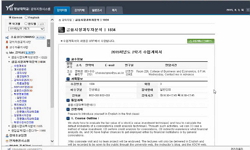According to the analysis results on Korean cattle cooperatives, it is considered that the conditions of members' welfare, payment and education were poor because of short establishment period and unexpected financial crisis. However, the representati...
http://chineseinput.net/에서 pinyin(병음)방식으로 중국어를 변환할 수 있습니다.
변환된 중국어를 복사하여 사용하시면 됩니다.
- 中文 을 입력하시려면 zhongwen을 입력하시고 space를누르시면됩니다.
- 北京 을 입력하시려면 beijing을 입력하시고 space를 누르시면 됩니다.
https://www.riss.kr/link?id=A3010985
- 저자
- 발행기관
- 학술지명
- 권호사항
-
발행연도
2001
-
작성언어
Korean
- 주제어
-
KDC
527.000
-
등재정보
KCI등재
-
자료형태
학술저널
- 발행기관 URL
-
수록면
492-512(21쪽)
- 제공처
- 소장기관
-
0
상세조회 -
0
다운로드
부가정보
다국어 초록 (Multilingual Abstract)
Results of the economic analysis on the cooperatives by farming system identified that the highest profitability and productivity were achieved by Type II on increasing value-added followed by Type I of concentrating on hanwoo production, Type III on selling input and Type IV on saving input. Investment analysis based on the amount of allowable investment limit also shows that all farming systems except Type II invested over an appropriate level. Most influential factors affecting cooperative's profitability were record keeping and selling type. The effects of the cooperatives' operating system and subsidy on profitability were statistically insignificant.
According to the analysis results on Korean cattle cooperatives, it is considered that the conditions of members' welfare, payment and education were poor because of short establishment period and unexpected financial crisis. However, the representative's farm management ability and planning was well prepared. Viewing the components of investment in the cooperative, while the proportion of investment in kind was getting bigger, investment in cash and in kind were increased by 28.6% and 78.2%, respectively compared with the beginning stage. Most of the investment in kind was destined to land and facilities. Per capita investment was increased by 11.6million won from 21.3million won at the beginning to 32.9million won. The component ratios of fixed capital such as facility and equipment were composed of 36.4% of subsidy, 43.1% of loan and 20.5% of self-support.
Results of the economic analysis on the cooperatives by farming system identified that the highest profitability and productivity were achieved by Type II on increasing value-added followed by Type I of concentrating on hanwoo production, Type III on selling input and Type IV on saving input. Investment analysis based on the amount of allowable investment limit also shows that all farming systems except Type II invested over an appropriate level. Most influential factors affecting cooperative's profitability were record keeping and selling type. The effects of the cooperatives' operating system and subsidy on profitability were statistically insignificant.
목차 (Table of Contents)
- Ⅰ.서론
- Ⅱ.한우법인의 경영구조 및 운영에 관한 경영진단
- 1.5단계 채점법에 의한 경영진단개요
- 2.한우법인의 경영진단결과
- Ⅲ.한우법인의 사업 형태별 경제성 분석
- Ⅰ.서론
- Ⅱ.한우법인의 경영구조 및 운영에 관한 경영진단
- 1.5단계 채점법에 의한 경영진단개요
- 2.한우법인의 경영진단결과
- Ⅲ.한우법인의 사업 형태별 경제성 분석
- 1.법인경영체의 설립추이
- 2.조사법인의 일반현황
- 3.조사법인의 사업 형태별 경제성분석
- Ⅳ.요약 및 결론
동일학술지(권/호) 다른 논문
-
- 한국농업정책학회, 한국축산경영학회
- 하서현
- 2001
- KCI등재
-
- 한국농업정책학회, 한국축산경영학회
- 김충실
- 2001
- KCI등재
-
- 한국농업정책학회, 한국축산경영학회
- 최윤상
- 2001
- KCI등재
-
- 한국농업정책학회, 한국축산경영학회
- 성명환
- 2001
- KCI등재





 RISS
RISS 스콜라
스콜라







